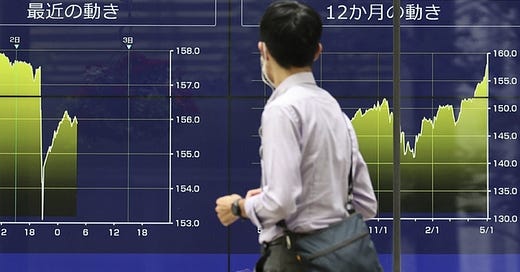Why is Japan's Ministry of Finance Hesitant to Intervene in the Forex Market?
On April 29, the Japanese yen experienced a significant fluctuation against the US dollar, dropping to a new low since 1986 at 160.17 yen before rebounding strongly to 154.54 yen, marking an unusu
On Monday, April 29, during mid-session trading in the Asian currency markets, the Japanese yen, which has been closely watched for some time, experienced another significant fluctuation: the yen briefly fell below a key level to 160.17 against the US dollar before making a strong rebound to 154.54 yen.
【🍃Spring Sale 🌷30% off for a yearly subscription | $3.5/month💰】
The Japanese yen experienced an unusually high intraday volatility, with fluctuations reaching as much as 5.63 yen. This level of activity is rare for the typically dynamic yen exchange rate. Moreover, the drop to 160 yen marked a new low since 1986, breaching a significant psychological barrier. Consequently, the sharp decline followed by a notable rebound sparked speculation about potential intervention by Japanese financial authorities in the currency market. The Wall Street Journal later reported with considerable certainty that there had indeed been official intervention, although this is difficult to confirm as Japan's Ministry of Finance did not acknowledge any involvement. Typically, data on official market operations are only published one month after the fact.
There is no doubt that the Japanese Ministry of Finance has a strong motivation to intervene in the market, whether or not it has already acted. For quite some time, facing the uncontrollable depreciation of the yen, senior officials at the Ministry have repeatedly stated that although there are pros and cons to the yen's depreciation, excessive volatility in exchange rates driven by speculation is detrimental to the economy. Therefore, it is essential to closely monitor the foreign exchange market and take appropriate measures when necessary.
Meanwhile, Japan's Ministry of Finance has been actively engaged in diplomatic efforts to lay the groundwork for future market interventions. For instance, on February 29, 2024, Masato Kanda, the Vice Minister of Finance for Japan, stated at a G20 meeting that excessive volatility of the yen is undesirable. He emphasized that the ministry was closely monitoring the foreign exchange market and was prepared to address any undue fluctuations in the yen. On April 17th in Washington D.C., a statement released after the Group of Seven (G7) finance ministers' meeting reaffirmed commitments made in May 2017 by member countries that excessive volatility and disorderly movements in exchange rates can adversely affect economic and financial stability, tacitly endorsing the legitimacy of interventions under certain conditions. On the same day, a joint statement issued following the inaugural trilateral finance ministers' meeting between the U.S., Japan, and South Korea also acknowledged concerns expressed by Japanese and Korean finance ministers about significant declines in their respective currencies.
As the Japanese yen continues to hit new lows against the U.S. dollar, calls from the public for authorities to intervene in the currency market are growing louder. Many small and medium-sized enterprises are facing pressures due to rising costs of imported materials. For households, although nominal wages are increasing, real wage growth adjusted for inflation is still declining, with a negative growth of 2.5% in 2023, leading to the first negative growth in consumer spending in three years.
Although Japan's Ministry of Finance has repeatedly stated that it will intervene in the market when necessary, timing such interventions requires extreme caution due to the high risk of failure. If intervention does not successfully curb the yen's decline, it could damage the ministry's credibility and paradoxically fuel speculative forces, exacerbating the depreciation of the currency.
In the view of the author, while international approval is necessary for intervening in the yen exchange rate, it is even more crucial to have the full support and cooperation of the Bank of Japan. However, current indications suggest that the Bank of Japan is not enthusiastic about this approach, and its views even diverge from those of the Ministry of Finance. For instance, Kazuo Ueda, Governor of the Bank of Japan, believes that a depreciating yen can stimulate demand and thus benefit the economy; he also argues that a weak yen does not significantly contribute to inflationary pressures.
For this reason, the Bank of Japan has not prioritized exchange rate stability in its monetary policy decisions. At the conclusion of its monetary policy meeting on April 26, while maintaining interest rates and emphasizing continued loose financial conditions, there was no indication of a future reduction in the scale or timing of government bond purchases. This stance somewhat undermined the yen. However, the Bank of Japan's balanced approach is also a necessity: despite the sharp decline in the yen's exchange rate, Japan's overall economic performance has been lackluster, with potential contraction in the first quarter.
Observers note that Japan's Ministry of Finance has set thresholds for intervening in the currency market, although these thresholds are subject to change. In September and October 2022, the ministry intervened three times when the yen fell to a target rate of no lower than 151.95 yen. Since the beginning of 2024, as the yen continued to hit new lows, 157.60 yen was considered a critical level. Another criterion for intervention is rapid fluctuation; if the yen moves by more than 10 yen within a month, it warrants close attention.
Based on recent exchange rate performance, there is no doubt that the criteria for intervention have been met; what is needed now is cooperation from the Bank of Japan, which remains challenging at present. Although the Bank of Japan recently raised its core CPI forecast for 2024 from 2.4% to 2.8%, consensus expectations for the next interest rate hike still point to October this year. Meanwhile, expectations for when the Federal Reserve will cut rates continue to be pushed back, and predictions about the extent of these cuts are gradually diminishing. The combined effect of these multiple factors will undoubtedly continue to exert pressure on the Japanese yen exchange rate.




